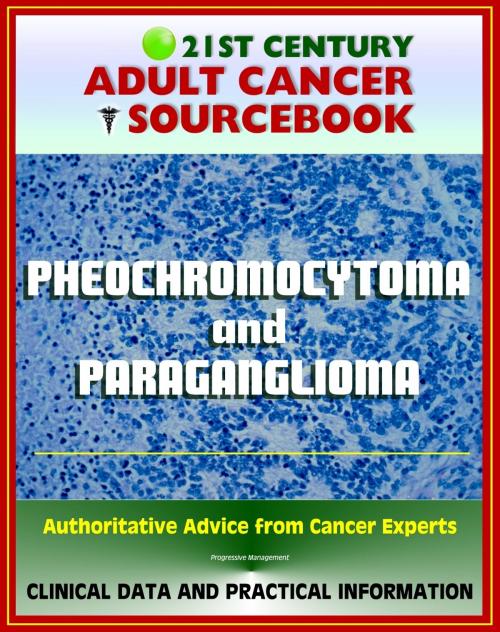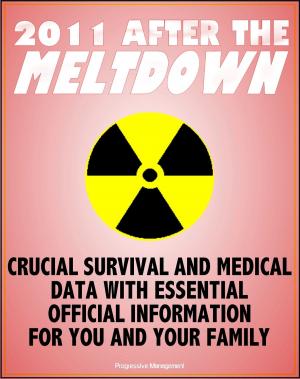21st Century Adult Cancer Sourcebook: Pheochromocytoma and Paraganglioma - Clinical Data for Patients, Families, and Physicians
Nonfiction, Health & Well Being, Health, Ailments & Diseases, Cancer| Author: | Progressive Management | ISBN: | 9781466189430 |
| Publisher: | Progressive Management | Publication: | October 25, 2011 |
| Imprint: | Smashwords Edition | Language: | English |
| Author: | Progressive Management |
| ISBN: | 9781466189430 |
| Publisher: | Progressive Management |
| Publication: | October 25, 2011 |
| Imprint: | Smashwords Edition |
| Language: | English |
Authoritative information and practical advice from the nation's cancer experts about pheochromocytomas and paragangliomas includes official medical data on signs, symptoms, early detection, diagnostic testing, risk factors and prevention, treatment options, surgery, radiation, drugs, chemotherapy, staging, biology, prognosis, and survival, with a complete glossary of technical medical terms and current references.
Starting with the basics, and advancing to detailed patient-oriented and physician-quality information, this comprehensive in-depth compilation gives empowered patients, families, caregivers, nurses, and physicians the knowledge they need to understand the diagnosis and treatment of pheochromocytomas and paragangliomas.
Comprehensive data on clinical trials is included - with information on intervention, sponsor, gender, age group, trial phase, number of enrolled patients, funding source, study type, study design, NCT identification number and other IDs, first received date, start date, completion date, primary completion date, last updated date, last verified date, associated acronym, and outcome measures.
Pheochromocytomas are usually benign (not cancer) but can cause high blood pressure, pounding headaches, heart palpitations, flushing of the face, nausea, and vomiting. Pheochromocytomas and extra-adrenal paragangliomas are rare tumors arising from neural crest tissue that develops into sympathetic and parasympathetic paraganglia throughout the body. Sympathetic paraganglia include the following:
• The adrenal medulla.
• The organ of Zuckerkandl near the aortic bifurcation.
• Other paraganglia along the distribution of the sympathetic nervous system.
Parasympathetic paraganglia include the following:
• The carotid body.
• Other paraganglia along the cervical and thoracic branches of the vagus and glossopharyngeal nerves.
The most recent World Health Organization classification utilizes the term pheochromocytoma exclusively for tumors arising from the adrenal medulla and the term extra-adrenal paraganglioma for similar tumors that arise from other locations.
The incidence of pheochromocytoma is 2 to 8 per million persons per year. Pheochromocytoma is present in 0.1% to 1% of patients with hypertension, and it is present in approximately 5% of patients with incidentally discovered adrenal masses. The peak incidence occurs in the third to fifth decades of life; the average age at diagnosis is 24.9 years in hereditary cases and 43.9 years in sporadic cases. The incidence is equal between males and females, and there are no known environmental, dietary, or lifestyle risk factors that have been linked to the development of pheochromocytoma.
Extensive supplements, with chapters gathered from our Cancer Toolkit series and other reports, cover a broad range of cancer topics useful to cancer patients. This edition includes our exclusive Guide to Leading Medical Websites with updated links to 81 of the best sites for medical information, which let you quickly check for updates from the government and the best commercial portals, news sites, reference/textbook/non-commercial portals, and health organizations. Supplemental coverage includes:
Levels of Evidence for Cancer Treatment Studies
Glossary of Clinical Trial Terms
Clinical Trials Background Information and In-Depth Program
Clinical Trials at NIH
How To Find A Cancer Treatment Trial: A Ten-Step Guide
Taking Part in Cancer Treatment Research Studies
Access to Investigational Drugs
Clinical Trials Conducted by the National Cancer Institute's Center for Cancer Research at the National Institutes of Health Clinical Center
Taking Time: Support for People with Cancer
Facing Forward - Life After Cancer Treatment
Chemotherapy and You
Authoritative information and practical advice from the nation's cancer experts about pheochromocytomas and paragangliomas includes official medical data on signs, symptoms, early detection, diagnostic testing, risk factors and prevention, treatment options, surgery, radiation, drugs, chemotherapy, staging, biology, prognosis, and survival, with a complete glossary of technical medical terms and current references.
Starting with the basics, and advancing to detailed patient-oriented and physician-quality information, this comprehensive in-depth compilation gives empowered patients, families, caregivers, nurses, and physicians the knowledge they need to understand the diagnosis and treatment of pheochromocytomas and paragangliomas.
Comprehensive data on clinical trials is included - with information on intervention, sponsor, gender, age group, trial phase, number of enrolled patients, funding source, study type, study design, NCT identification number and other IDs, first received date, start date, completion date, primary completion date, last updated date, last verified date, associated acronym, and outcome measures.
Pheochromocytomas are usually benign (not cancer) but can cause high blood pressure, pounding headaches, heart palpitations, flushing of the face, nausea, and vomiting. Pheochromocytomas and extra-adrenal paragangliomas are rare tumors arising from neural crest tissue that develops into sympathetic and parasympathetic paraganglia throughout the body. Sympathetic paraganglia include the following:
• The adrenal medulla.
• The organ of Zuckerkandl near the aortic bifurcation.
• Other paraganglia along the distribution of the sympathetic nervous system.
Parasympathetic paraganglia include the following:
• The carotid body.
• Other paraganglia along the cervical and thoracic branches of the vagus and glossopharyngeal nerves.
The most recent World Health Organization classification utilizes the term pheochromocytoma exclusively for tumors arising from the adrenal medulla and the term extra-adrenal paraganglioma for similar tumors that arise from other locations.
The incidence of pheochromocytoma is 2 to 8 per million persons per year. Pheochromocytoma is present in 0.1% to 1% of patients with hypertension, and it is present in approximately 5% of patients with incidentally discovered adrenal masses. The peak incidence occurs in the third to fifth decades of life; the average age at diagnosis is 24.9 years in hereditary cases and 43.9 years in sporadic cases. The incidence is equal between males and females, and there are no known environmental, dietary, or lifestyle risk factors that have been linked to the development of pheochromocytoma.
Extensive supplements, with chapters gathered from our Cancer Toolkit series and other reports, cover a broad range of cancer topics useful to cancer patients. This edition includes our exclusive Guide to Leading Medical Websites with updated links to 81 of the best sites for medical information, which let you quickly check for updates from the government and the best commercial portals, news sites, reference/textbook/non-commercial portals, and health organizations. Supplemental coverage includes:
Levels of Evidence for Cancer Treatment Studies
Glossary of Clinical Trial Terms
Clinical Trials Background Information and In-Depth Program
Clinical Trials at NIH
How To Find A Cancer Treatment Trial: A Ten-Step Guide
Taking Part in Cancer Treatment Research Studies
Access to Investigational Drugs
Clinical Trials Conducted by the National Cancer Institute's Center for Cancer Research at the National Institutes of Health Clinical Center
Taking Time: Support for People with Cancer
Facing Forward - Life After Cancer Treatment
Chemotherapy and You















